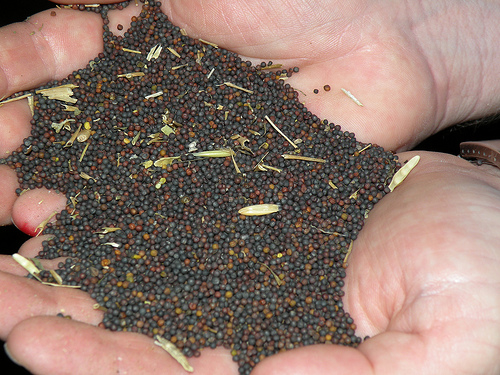
Agricultural News
Huge Increase In Winter Canola Acres Expected as Planting Window Approaches
Wed, 04 Sep 2013 11:53:08 CDT

Between 400,000 and 500,000 acres of winter canola will be planted in the Southern Great Plains in the next two months, according to Gene Neuens, Producers Cooperative Oil Mill oilseed field representative..
"There will be more winter canola planted in this region than any other time in the crop's short history," Neuens said. "To be eligible for crop insurance the crop must be planted between Sept. 10 and Oct. 10 each year. In most of the area, there is a pretty good supply of moisture in the top soil to get the seed started."
Neuens said winter canola planting season in Kansas starts Sept. 1. Just returning from several field days in the southern part of the state, he said a lot of winter canola is being planted now or will soon be planted.
"Other good news for us is farmers already established in winter canola production have indicated they are increasing their acres planted to the crop," he said."And we know there are many farmers who are planting canola for the first time this year. Both of these developments, along with seed companies reporting their seed supplies are dwindling, make us believe this will be a bumper year for canola planted."
In 2012, more than 300,000 acres were planted and in spite of the drought and late spring freezes in 2013, more than 200,000 acres were reported to be harvested, he said.
"Even in drier areas, knowledgable farmers have learned you can dust in canola seed similar to planting winter wheat," Neuens said. "In order to take advantage of good planting weather, for a long time farmers have planted wheat in in dry, dusty seed beds, gambling on later rains to germinate the crop and get a stand.
"At first, we preferred to plant canola only when we had sufficient soil moisture to establish a crop," he said. "Recently, the drought forced farmers to plant canola in dry fields. Later rain showers provided enough moisture to bring the crop up."
Traveling to farmer meetings, Neuens has seen farmers farther west and north in Texas and New Mexico plant winter canola. Each succeeding year, the benefits of the crop are encouraging more farmers to plant a field or two to canola.
"After the first year, they see canola being rotated with winter wheat provides several positive effectsl," Neuens said. "In the first place, the crop was developed by Oklahoma State University and Kansas State University agronomists as a crop intended to rid wheat fields of perennial weeds. Decades of continuously-grown winter wheat in the Southern Plains states caused weeds like cheat grass and winter rye to increase. Seed from these weeds were spread from region to region by grain trucks and farming equipment being transported long distances over the interstate highways.
Seed from these weeds winds up in harvested wheat seed taken to grain elevators to be sold by farmers. Weed seed found in wheat causes severe price dockage and robs the farmers of much-needed income.
Winter canola started as a spring crop in Canada and northern US farm states. Crop breeders changed canola into a cool-season crop. Knowing it is a completely different crop than winter wheat, agronomists encouraged farmers to begin growing the crop after wheat. Grown after wheat, canola disrupts the growth cycle of weeds and when rotated with wheat cleans up fields historically infested with the weeds.
"Over the past decade or so, we have found canola is best rotated with wheat in a two or three year rotation," Neuens said. "It really cleans up wheat fields. At the same time, it is a good money crop and many farmers are growing canola along with wheat, grain sorghum, hay, cotton and corn with all of them bringing a profit to the farmer."
While the price paid for winter canola varies seasonally the same as other crops, it's price usually is three to four dollars per bushels more than prices paid for winter wheat, Neuens said.
By Vic Schoonover, Producers Cooperative Oil Mill
WebReadyTM Powered by WireReady® NSI
Top Agricultural News
More Headlines...



















